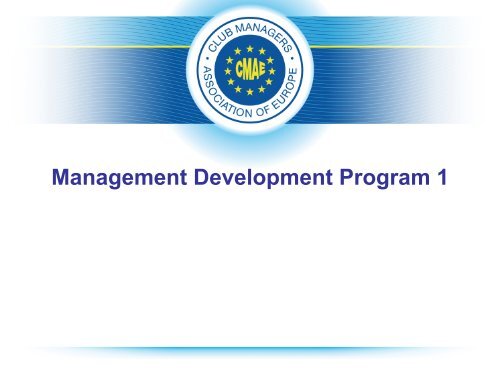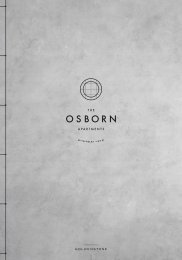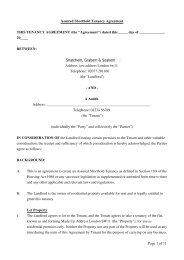MDP1 london 17 7 17 ppt
Create successful ePaper yourself
Turn your PDF publications into a flip-book with our unique Google optimized e-Paper software.
Management Development Program 1
Management Development Programme Part 1
Today’s Aims<br />
Get the week off to a good start...<br />
• Journey from Management to Leadership<br />
• Lead and Manage Change<br />
• Enhance Delegation Capabilities
• Einstein * light bulb<br />
Management to Leadership<br />
Learning Outcomes:<br />
• Understand the differences between Management and Leadership<br />
• Characteristics of Good / Bad Managers<br />
• Assess yourself against Leadership models - identify your<br />
strengths and development needs<br />
• Appreciate the importance of a positive and supportive managerial<br />
environment /climate on your Club<br />
• How to lead and manage change, and enhance delegation skills
Management Development Programme<br />
• Timings<br />
• Keep an open mind and share your experiences<br />
• Mobiles<br />
• Fire Exit<br />
• Participants material – sign it!<br />
• Ask Questions….keys= Fun!<br />
• Lets get to know each other in teams<br />
• Feedback during the day and at the END…5/5<br />
• What will make this a WOW day!
INSANITY<br />
“Doing the same thing OVER & OVER and<br />
expecting different results”<br />
Albert Einstein
Introductions<br />
• Introduce yourself<br />
• What you do and where<br />
• Years of experience working in clubs (total for team)<br />
• Share one secret!<br />
• Create team name<br />
• What is your Number 1 expectation from this day?
Darshan Singh
Management Functions/Roles/Responsibility<br />
Core Functions<br />
§ Planning<br />
§ Organizing<br />
§ Staffing<br />
§ Directing<br />
§ Controlling & Coordinating<br />
§ Reporting<br />
§ Budgeting<br />
Luther Gullick
Management Role (TPS split) Katz Model
Managers Recall ....<br />
Good Managers<br />
• You have worked for…<br />
• List of their characteristics, traits, abilities, behaviours or skills<br />
• …<br />
• …<br />
Bad Managers<br />
• List of their characteristics, traits, abilities, behaviours or skills<br />
• …<br />
• …<br />
– FC (Post-it)
Good / Bad Managers - Handout Appendix 1<br />
Good Managers<br />
Good communicators / listeners<br />
Make employees feel at ease<br />
Interested in employees’ ideas<br />
Open minded / encourages innova;on<br />
Usually have ;me to spend with<br />
employees<br />
Are genuinely interested in employees’<br />
wellbeing<br />
Recognize employees for a job well<br />
done<br />
Create an atmosphere of trust<br />
Creates an environment that makes<br />
employees and individuals feel<br />
important<br />
Bad Managers<br />
Poor communicators / listeners<br />
Do not make employees feel at ease<br />
Not interested in employees’ ideas<br />
Closed minded / discourages<br />
innova;on<br />
Do not usually have ;me to spend with<br />
employees<br />
Are not interested in employees’<br />
wellbeing<br />
Create an atmosphere of distrust<br />
Create an atmosphere of trust<br />
Creates an environment that makes<br />
employees and individuals feel<br />
unimportant<br />
Which of the two columns most closely describes you?<br />
Score yourself on a scale of 1=never 5=Always against Good Manager!
Journey from Management to Leadership<br />
Managers are people who do things right<br />
Leaders are people who do the right things<br />
Manager has his eye on the bottom line<br />
Leader has his eye on the horizon<br />
Management is efficiency in climbing ladder of success,<br />
Leadership determines whether the ladder is leaning against the right<br />
wall<br />
What are your thoughts?<br />
Leadership is not Management because<br />
You Manage Things<br />
You Lead People
Management to Leadership<br />
Manager<br />
§ Administer<br />
§ Maintain<br />
§ Short-term view<br />
§ Ask how and when<br />
§ Accept the status quo<br />
§ Focus on things<br />
§ Organize<br />
§ Direct<br />
§ Control<br />
§ Do things right<br />
Leader<br />
§ Innovate<br />
§ Develop<br />
§ Long-term view<br />
§ Ask what and why<br />
§ Challenge the status quo<br />
§ Focus on people<br />
§ Influence<br />
§ Motivate<br />
§ Build<br />
§ Do the right things
Evolution of Leadership Models & Approaches<br />
Historical<br />
Trait Leadership<br />
Leaders are born<br />
Historical<br />
Grid Leadership<br />
Leaders can<br />
be trained on<br />
two dimensions<br />
Concern<br />
for People &<br />
Concern<br />
For Production<br />
Current<br />
Situational<br />
Leadership<br />
Leaders<br />
Match Style<br />
to Needs of<br />
Others &<br />
Situation<br />
Inspirational Leadership
Traits Leadership Model (Leaders Are born)<br />
Majority of people admire and willing to follow leaders with the<br />
following traits:<br />
§ Ambitious<br />
§ Intelligence<br />
§ Originality<br />
§ Honesty<br />
§ Sociability<br />
§ Creative<br />
§ Adaptability<br />
§ Confident<br />
§ Inspiring<br />
§ Driven<br />
§ Initiative<br />
§ Courageous<br />
§ Aggressive<br />
§ Humble<br />
“Real leaders must be ready to sacrifice all for the freedom<br />
of their people” …Nelson Mandela<br />
Leadership at one time meant muscles; but it also means<br />
getting along with people…Mahatma Gandhi
Traits Leadership Model (Leaders Are born)<br />
“At Microsoft there are lots of brilliant ideas, but the image is that<br />
they all come from the top - I'm afraid that's not quite right.<br />
As we look ahead into the next century, leaders will be those who<br />
empower others” …Bill Gates<br />
"My job is not to be easy on people.<br />
My job is to take these great people we have and to push<br />
them and make them even better. Leadership is the art of<br />
giving people a platform for spreading ideas that work" …<br />
Steve Jobs .
Kurt Lewin Behavioral Leadership Model<br />
• Autocratic- Leaders make decisions alone, and instruct<br />
subordinates<br />
• Democratic- Leaders involve subordinates in the decisionmaking<br />
process, but in end take final decision<br />
• Laissez-Faire- Allow subordinates to make decisions on their<br />
own with little guidance or support
Lewin’s Behavioral Leadership Model- Style Inventory<br />
• Behavioral Leadership Style Inventory :- Assess Your own<br />
Leadership Behaviour<br />
Appendix 2….
The Leadership Grid (Blake & Mouton) Model<br />
Vertical axis – leader considers needs of team<br />
members, interests, personal over to do a task<br />
High<br />
Concern for people<br />
9<br />
1,9 Leadership<br />
Thoughtful attention to<br />
8<br />
needs of people for<br />
satisfying relationships<br />
leads<br />
7<br />
to a comfortable,<br />
friendly organization<br />
atmosphere and work<br />
tempo.<br />
6<br />
5<br />
4<br />
3<br />
2<br />
1<br />
Country Club<br />
1,1 Leadership<br />
Exertion of minimum<br />
effort to get work<br />
done is appropriate<br />
to sustain organization<br />
membership.<br />
Middle-ofthe-Road<br />
5,5 Leadership<br />
Adequate organization<br />
performance is possible<br />
through balancing the<br />
necessity to get out<br />
work with maintaining<br />
morale of people at a<br />
satisfactory level.<br />
Team Leadership<br />
9,9 Leadership<br />
Work accomplisment is<br />
from committed people.<br />
Interdependence<br />
through<br />
a "common stake" in<br />
organization purpose<br />
leads to relationships<br />
of trust and respect.<br />
9,1 Leadership<br />
Efficiency in operations<br />
results from arranging<br />
conditions of work in<br />
such a way that human<br />
elements interfere to a<br />
minimum degree.<br />
Low 1 2 3 4 5 6 7 8 9<br />
Low<br />
Impoverished<br />
Concern for production<br />
Authority-<br />
Compliance<br />
High<br />
Horizontal axis – leader emphasizes objectives, high productivity
The Leadership Grid (Blake & Mouton) Model<br />
• Authority-Compliance<br />
• people are tools for getting the job done<br />
• communication is for instructions<br />
• Autocratic, strict policies, procedures<br />
• Punishment used to motivate<br />
• Country Club Management<br />
• Highly concerned for personal and social needs of followers, usually<br />
fun, relaxed environment<br />
• Impoverished Management (Limited)<br />
• No commitment - No regard for creating systems to get job done<br />
• No regard to create motivating work environment<br />
• Result is disorganization, dissatisfaction
The Leadership Grid (Blake & Mouton) Model<br />
• Middle-of-the-Road Management<br />
§ Compromisers, avoid conflicts, emphasize moderate<br />
levels of production<br />
§ Neither production/people needs fully met due to<br />
compromise<br />
• Team Management<br />
§ Pinnacle of Leadership style<br />
§ Production/needs of people equally high<br />
§ Stimulate participation, acts determined, makes<br />
priorities clear, behaves open-mindedly
Dr. Paul Hersey & Ken Blanchard Situational Model-Approach<br />
• Leadership is Dynamic<br />
Dr.Paul Hersey<br />
• Different situations demand different kinds of<br />
leadership<br />
• Being an effective leader requires that an individual to<br />
adapt his/her style/behaviour to the demands of<br />
different situations and levels of maturity<br />
• Leadership is also dependent upon the<br />
ability of followers<br />
Ken Blanchard
Situational Leadership, Four Styles<br />
High<br />
Relationship Behavior<br />
Low<br />
Delegating<br />
Task Behavior<br />
Directing<br />
High<br />
Able and<br />
willing<br />
Able and<br />
unwilling<br />
Unable and<br />
willing<br />
Unable and<br />
unwilling<br />
Developed<br />
High skill<br />
High<br />
Motivation<br />
High skill<br />
Low<br />
Motivation<br />
Low skill<br />
High<br />
Motivation<br />
Low skill<br />
Low<br />
Motivation<br />
Developing<br />
Follower Readiness
Dr. Paul Hersey & Ken Blanchard Situational Approach<br />
§ Directing/Telling<br />
• Tell people what to do, and how to do it. One-way communication<br />
• Focused on goal achievement, careful supervising of instructions<br />
§ Coaching/Influence/Selling<br />
• Still provides info/direction, but with more communication<br />
• ‘Sell’ message to get team on board<br />
• Encouragement and soliciting subordinate input<br />
• Leader makes the final decision<br />
• Task vs People orientation…..the above focused on getting task done
Dr. Paul Hersey & Ken Blanchard Situational Approach<br />
§ Supporting/Collaboration/Participating<br />
• Focus more on relationship, less on direction.<br />
• Works with the team, shares decision making<br />
• Brings out the employee’s skills around the task, subordinates<br />
control for day-to-day decisions<br />
• Listening, praising, asking for input, giving feedback<br />
§ Delegating<br />
• Low level of involvement in planning, control of details, goal<br />
clarification<br />
• Leaves the responsibility to subordinates<br />
• Task vs People Orientation – above focused more on developing<br />
team members
Situational Leadership, Four Styles<br />
High<br />
Relationship Behavior<br />
Low<br />
Delegating<br />
Task Behavior<br />
Directing<br />
High<br />
Able and<br />
willing<br />
Able and<br />
unwilling<br />
Unable and<br />
willing<br />
Unable and<br />
unwilling<br />
Developed<br />
High skill<br />
High<br />
Motivation<br />
High skill<br />
Low<br />
Motivation<br />
Low skill<br />
High<br />
Motivation<br />
Low skill<br />
Low<br />
Motivation<br />
Developing<br />
Follower Readiness
Situational Leadership- Video
Applying Situational Approach- Examples<br />
You've just finished training the newest member of your team. Now that he's ready to start working,<br />
you give him the data that you need him to enter into the company's database, and then you hurry off<br />
to a meeting.<br />
When you return later that afternoon, you're disappointed to find that he hasn't done anything. He didn't<br />
know what to do, and he didn't have the confidence to ask for help. As a result, hours have been lost,<br />
and now you have to rush to enter the data on time.<br />
“Although you may want to blame the new team member, the truth is that you're as much to blame as<br />
he is.”<br />
§ What level of maturity was the new team member ?<br />
§ Unable & Unwilling<br />
§ What leadership style did you use?<br />
§ Delegating<br />
§ What leadership style should you have used?<br />
§ Directing
Applying Situational Approach - Examples<br />
§ You're about to leave for an extended holiday, and your role will be handled by an experienced<br />
colleague. He's very familiar with your responsibilities, and he's excited to do the job. Instead of<br />
trusting his knowledge, and skills to do the work, you spend hours creating a detailed list of tasks for<br />
which he'll be responsible, and instructions on how to do them.<br />
§ The result? Your work gets done, but you've damaged the relationship with your colleague by your<br />
lack of trust.”<br />
What level of maturity was your colleague at?<br />
§ Able and willing<br />
What leadership style did you use?<br />
§ Directing<br />
What leadership style SHOULD you have used?<br />
§ Delegating
Inspirational Leadership Model (IDEA)
Inspirational Leaders<br />
• Genuinely Care about their PEOPLE<br />
• Involve everybody<br />
• Show lots of Appreciation<br />
• Ensure work is Fun<br />
• Show real Trust<br />
• Good Listener<br />
CMI UK Survey
Inspirational Leadership – Appendix 3 & 4<br />
Imagine if each statement relates to your Golf Club….<br />
Please respond to each statement below by ticking the appropriate box where:<br />
SA = strongly agree, A = agree, D = disagree, SD = strongly disagree<br />
1. There is a feeling of energy, fun and excitement in my organization.<br />
2. Our leaders( Dept Heads) are good communicators and they listen more than they talk<br />
3. We encourage creativity and innovation.<br />
4. Our leaders present an open and honest face to our staff.<br />
5. Our leaders show a genuine appreciation of contribution and efforts.<br />
6. Leaders in my organization are genuinely in touch with how people are feeling.<br />
7. We all work hard but senior management also makes sure we have fun.<br />
8. Everyone in this organization is constantly looking to do things better.<br />
9. In this organization people are helped to develop personally.<br />
10. Our leaders ensure objectives are stretching but not to the point of overload.<br />
11. It is commonplace for leaders to thank people when they have done a good job.<br />
12. Leaders in my organization are approachable / have real open door policy.<br />
13. I am confident that our leaders listen to others’ views.<br />
14. People are actively encouraged to come up with ideas / be creative.<br />
15. Our leaders trust people to make their own day-to-day decisions.
Managing & Leading Change<br />
@ Your Club
Managing Change - Learning Outcomes<br />
• Stimulate thought on Change & promote positive ownership for<br />
Change<br />
• Understand what is involved in the process of Change Management<br />
• Better understand and response to Change<br />
• Identify what needs to Change<br />
• Effectively Lead Change @ your Club
Change<br />
• The only thing constant is the word CHANGE….<br />
• The greatest challenge for Leaders is Organizational Change,<br />
taking it to the next level….<br />
• Japanese call it Kaizen which means:<br />
Continuous Improvement<br />
• Change challenges Leaders/ Managers…<br />
• Change can happen in split second!<br />
• Change is good, so don’t be afraid….<br />
Just look at all the major changes in your life to-date….
What is Change?<br />
• The implementation of new procedures or technologies intended to<br />
realign an organization with the changing demands of its business<br />
environment, or to capitalize on business opportunities<br />
• Change – new state of being, different from old state of things<br />
• “A set of social science techniques designed to plan, and implement<br />
in work settings for purposes of enhancing the personal<br />
development of individuals and improving the effectiveness of<br />
organizational functioning”<br />
- Greenberg<br />
Change interventions = strategies for implementing change<br />
Change agents = people improving the organization’s functioning
Why Change ? Flipchart responses…<br />
Poor alignment to organization’s strategy<br />
Inappropriate organization structure<br />
Low productivity<br />
Organization<br />
Poorly designed tasks<br />
Intergroup conflict<br />
Interpersonal conflicts<br />
Inappropriate leadership style
Readiness for Change at your Club- Appendix 5<br />
This questionnaire may be used to measure readiness for a<br />
specific change or as a general indicator of an Club/<br />
Organisation’s readiness to manage change (at conceptual<br />
level).<br />
Circle the number that best represents your opinion about<br />
your Club/ Organisation on the basis of:<br />
3: Yes 2: Somewhat 1: No
16 Indicators of Readiness for Change<br />
• Support from a senior level<br />
• All levels of management<br />
committed<br />
• A culture of managed risk<br />
taking<br />
• Encouragement and reward<br />
for improvement<br />
• Articulation of the need for<br />
change<br />
• Clear vision of a positive future<br />
• Specific performance<br />
measures<br />
• Integration of effort<br />
• Benchmark against ‘world class’<br />
• All employees understand<br />
customer needs<br />
• Reward for innovation and root<br />
cause solutions<br />
• Organisation is flexible and<br />
cooperative<br />
• Effective communication at all<br />
levels<br />
• Track record of implementing<br />
change<br />
• Employees take personal<br />
responsibility<br />
• Decisions made quickly
Analytical Tools for Change<br />
• SWOT Analysis<br />
• SOAR ( Strengths, Opportunities, Aspirations, Results)<br />
• PESTEL (Political, Economic, Social, Technological,<br />
Environmental, Legal)<br />
• WWW ( What went well)<br />
• EBI (Even better if)
The Change Curve: (Elizabeth Ross)<br />
Performance & Employee Motivation<br />
•<br />
Shock<br />
Denial<br />
Frustration<br />
Guilt/ Self-blame<br />
Commitment<br />
Understanding<br />
Testing<br />
Acceptance<br />
Time
The Change Curve: (Elizabeth Ross)<br />
1.Shock: This is when individuals, faced by the change, are in a<br />
state of:<br />
1. Shock,<br />
2. Cannot take it all in<br />
3. Often find themselves disbelieving it.<br />
2.Denial: This is when individual may reject the change, by:<br />
1. Trying to create the situation in their own mind where<br />
they refuse to believe change is happening.<br />
2. Looking for proof to clarify that this change will never<br />
happen.
The Change Curve: (Elizabeth Ross)<br />
3.Frustration: At this stage, an individual:<br />
1. Is still in denial that the change is happening.<br />
2. Is frustrated at inability to influence change<br />
3. Looks for somebody else to blame.<br />
4.Guilt/ Self Blame: A very difficult stage for some individuals in<br />
the change curve.<br />
1. They feel very helpless<br />
2. They will be looking around to see others coping with<br />
change, while they cannot.<br />
3. Hence, they will blame themselves.
The Change Curve: (Elizabeth Ross)<br />
5. Acceptance: After a period of time, an individual:<br />
1. Begins to think that things cannot be any worse.<br />
2. Begins to consider the New.<br />
3. Starts to forget the old attitudes.<br />
4. Starts to accept new ways.<br />
5. Thinks of ways to adjust with change/s.<br />
6. Testing: This is where individuals begin to:<br />
1. Buy the change,<br />
2. Start feeling Positive about it.<br />
3. Try out the new practices & behaviors.<br />
4. Start feeling Good about the change.
Kurt Lewin 3 Step Change Model<br />
Kurt Lewin<br />
Kurt Lewin
Applying Lewin’s Model to the Organization<br />
Unfreezing:<br />
§ Recognizing the need for change<br />
§ The organization eliminates rewards for current behavior<br />
Changing:<br />
§ Attempting to create a new state of affairs<br />
§ The organization initiates new options and explains their rationale<br />
Refreezing:<br />
§ Incorporating the changes, and maintaining a new organizational system<br />
§ Organizational culture & formal reward<br />
§ Systems encourage the new behaviors
Kotter's 8-Step Change Model<br />
John Ko0er
Kotter's 8-Step Change Model
Barriers to Change<br />
• Fear of the unknown<br />
• Economics<br />
• Inconvenience<br />
• Threats to interpersonal relations
Reducing Resistance to Change<br />
• Build trust<br />
• Discuss upcoming change<br />
• Involve the affected parties<br />
• Make sure changes are reasonable<br />
• Avoid threats<br />
• Follow a sensible time schedule<br />
• Implement in the most logical way<br />
• …<br />
Remember: It’s all about the Environment you establish!
What major Changes are needed at your Club?<br />
List the top 3:<br />
1. ..<br />
2. ..<br />
3. ..
Delegation<br />
“Here lies a man who knew, how to enlist<br />
in his service better men than himself”<br />
CARNEGIE’S EPITAPH
Delegation - Learning Outcomes<br />
• Ways to improve the quantity and quality of delegation<br />
• Knowing when to delegate, and when not to delegate<br />
• A clear value for delegation and ideas for ways to<br />
remove blocks to delegation<br />
• An effective process and planned approach to<br />
Delegation
Why Delegate?<br />
• What are the advantages and disadvantages of<br />
delegation?....
Tasks which cannot be Delegated<br />
• Matters essential to your overall control of the Club<br />
• Discipline of team member's or colleagues<br />
• Confidential, Financial, Security and policy matters<br />
restricted to Club Managers level
Why do managers resist Delegation<br />
• “If you want anything done right around here do it<br />
yourself”… (fear of subordinate failure)<br />
• “It is easier to do it myself than to teach these idiots<br />
around here how to do it”…<br />
• Fear of subordinate looking “too good”<br />
• Human attraction to power<br />
• Loss of control<br />
• Manager feels comfortable in doing the task of the<br />
previous job held
Why employees don’t do the work Delegated to them?<br />
• It’s easier to ask the boss than to make a decision<br />
• Fear of criticism<br />
• Lack of incentive<br />
• Some feel that certain work is beneath them<br />
• Some figure that the boss will change it anyway<br />
• ….any other reasons…
Steps of the Delegation Process<br />
1. Analyze how you spend your time<br />
2. Decide which tasks can be assigned<br />
3. Decide who can handle each task<br />
4. Delegate the authority<br />
5. Create an obligation (responsibility/<br />
accountability)<br />
6. Control the Delegation.
Delegation checklist<br />
• Have a clear and precise vision of the task<br />
• Explain exactly what you expect<br />
• Explain why the task has to be done<br />
• Show them how and set standards<br />
• Agree training and support required<br />
• Ask them to describe their understanding<br />
• Provide all relevant information<br />
• Agree timescale and schedule<br />
• Provide whatever support is required<br />
• Ask for reports/updates<br />
• Monitor and evaluate<br />
• Reward and encourage as required
Delegation Planning<br />
• Plan your delegation for<br />
at least one task /<br />
responsibility for at least<br />
one person<br />
• Complete Appendix -7
Framework for Leadership Action @ your Club<br />
Identify key Leadership Challenges….<br />
define<br />
objectives<br />
evaluate<br />
plan<br />
monitor/<br />
support<br />
brief
Way forward…<br />
• Update Personal Learning Journal (plj),<br />
• SMART(S) Actions<br />
• Traffic lights analogy to developing Leadership behaviours:<br />
• Stop<br />
• Start<br />
• Continue<br />
• Reflect over a glass of wine and continue the learning journey...
Today’s Aims<br />
• Get the week off to a good start...did we!<br />
• Journey from Management to Leadership<br />
• Understand and Lead Change<br />
• Improve your Delegation capabilities
Darshan Singh<br />
Management Consultant<br />
MTI Consulting, Bahrain<br />
Email: darshan@mtiworldwide.com<br />
Skype: Hanson.Singh, Bahrain<br />
Face Time: Darshan2005@hotmail.com<br />
Mobile: ++ 973 39695683

















